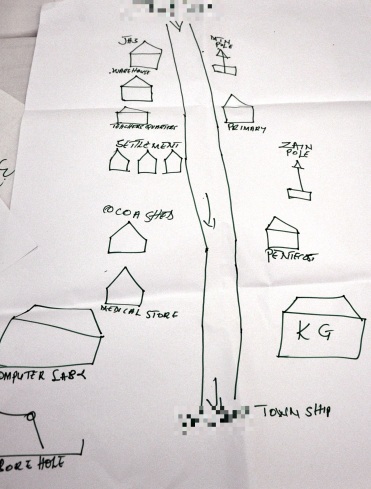Similarly to the discussion at the Adwoa (anonymized) community, the discussion at the Kwadwo (anonymized) community was organized with the help of extension officers from the district office. The setting selected for the meeting was a local church, which induced a more formal atmosphere into the interactions.

The discussion started by considering recent developments and participants recounted that they did not have electricity until 2008. Nonetheless, as the community has had a surfaced road, its population increased considerably. Immigration into the community was largely due to surface mining activities which take place in the area. Farmers estimated that more than 30 tro-tros (i.e. public mini-buses) visit the community each day. Despite the high level of traffic, there was no newspaper delivery, nor sales in the area. The most memorable adverse event in recent years was the famine of 1983, when many cocoa farms were burnt as a result of the hot weather and absence of rain. Nonetheless, the farms were re-established after the famine was over. In recent years, improved efforts by the public extension office helped improve farmers’ yields. among the remaining problems was black pod disease which still affected yields and the affordability of fungicide in order to control the disease.

Out of the 13 farmers at the meeting, 9 had access to radios, and they could list more than 20 radio stations which could be received in the area. Farmers tended to use their radios in order to listen to the news. Five out of 13 people in the focus group said they owned television sets but they also said tv signals are not the best. They had access to 4 TV channels: GTV, Metro TV, TV Africa and TV 3. The community had a school but no library. The community had 1 mosque and “uncountable” number of churches. The locations of 4 churches were marked on the participatory map.

The loudspeaker in the community was known as an ‘information center’, and it served for making announcements about community labour, farmer meetings, funerals and local other information. The fee for announcements (GhC 1) included the announcement being aired twice. Farmers remarked that loudspeakers were often used by salesmen, traveling by car, in order to promote their merchandise (e.g. medicines). The community had no town crier.
Mobile phones were not too common among the farmers in the meeting and only 4 indicated that they own cell phones; out of them had devices with radio functionality. Those who did not own mobile phones made calls from the shared ‘space-to-space’ facilities. These are fixed mobile phone facilities operated by salesmen of mobile credit vouchers. Their location is marked on the map with an umbrella, as they are also known as “umbrella salesmen”.



